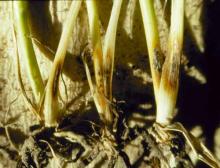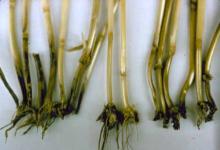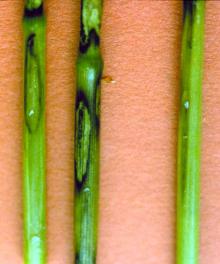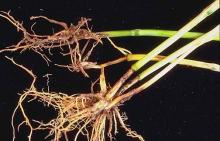See:
Wheat (Triticum aestivum) - Common Root Rot (Seedling Blight)
Barley (Hordeum vulgare) - Eyespot
Cause The fungi, Oculimacula yallundae (syn. Tapesia yallundae; anamorph Helgardia herpotrichoides; syn. Pseudocercosporella herpotrichoides) and O. acuformis (syn. T. acuformis; anamorph H. acuformis). These fungi survive on infected crop residue in soil and causes disease on barley, oats, rye, and grasses as well as wheat. Because cool temperatures, wetter soils, and high humidity favor the disease; planting date, winter temperatures, and disease levels in the previous wheat crop will affect the amount of disease in a field. Tilling winter wheat in spring, like harrowing for weed control or shank application of fertilizer, increases the amount of foot rot damage. Applying more nitrogen than recommended also increases disease incidence.
Symptoms A disease called sharp eyespot, caused by Rhizoctonia cerealis, is often confused with eyespot caused by O. yallundae and O. acuformis. Distinguishing between eyespot and sharp eyespot is important in making decisions about fungicide applications.
The diagnostic symptom of eyespot is elliptical (eye-shaped) spots on leaf sheaths. Lesions are white to light brown at first, then turn dark. Later, the stem's base is attacked, and gray fungus may grow in the center of the infected area, whose margins are indistinct. Stems shrivel at the base and plants may lodge. Diseased tillers may mature early, producing white heads. Otherwise, heads are small and fill poorly under moisture stress and high temperatures.
The symptoms of sharp eyespot are also elongated, eye-shaped lesions. However, sharp eyespot lesions are bordered by a dark brown edge that sharply delineates the infected area from surrounding tissue. Centers of sharp eyespot lesions often are covered with white fungal growth, and centers fall out, leaving a characteristic hole.
Cultural control
- The soft white wheat varieties Coda, Foote, Gene, Hyak, Madsen, Temple, and Weatherford have moderate resistance to eyespot.
- Late-fall seeding can substantially reduce disease severity.
- Minimal tillage and no-till practices reduce disease incidence compared to conventional tillage (moldboard plow, disc, harrow).
- Plant spring wheat or barley in areas with a severe history of this disease.
- Rotating to legumes, or spring cereals for 3 or more years reduces the inoculum available to infect the next wheat crop.
Scouting Chemical applications are recommended for susceptible varieties when 10% or more of stems sampled are infected with eyespot. When sampling, examine at least 50 stems per field (more is better), and take them from across all the field, not just near the road. Be careful not to count lesions of sharp eyespot. Check fields several times during the potential application period (late February or March); the disease may increase after the earlier check.
Fields of susceptible varieties with 10% or more stems with eyespot lesions usually respond to chemical treatment by yielding 20% more than if left untreated. To determine whether a chemical application is cost-effective, multiply 20% by your yield potential, times the price you expect to get for the wheat. This gives you a conservative estimate of the potential investment return on your fungicide. For example, if yield potential is 30 bu/A, applying fungicide may save 6 bu/A (30 x 0.2). At $3 to $5/bu, the return is $18 to $30, minus the fungicide and application costs.
Chemical control Apply fungicides as soon as 10% of stems are affected. Apply when the fungicide spray can easily penetrate to the crown area of the plant. Do not apply after stems begin elongating or after the foliage closes between rows, because leaves protect the crown area from the spray. In most areas, best spray time is late February or in March. Apply any chemical only in combination with cultural controls, above.
- Miravis Ace (Group 3 + 7) at 7 to 13.7 fl oz/A. For use in Oregon and Washington only. Apply at herbicide timing near the beginning of stem elongation for suppression of eyespot. Harvest interval is 7 days for forage and hay. 12-hr reentry.
- Quilt Xcel (Group 3 + 11) at 14 fl oz/A plus half the rate recommended of another appropriate labeled fungicide. Apply at tillering but before elongation has occurred. Preharvest interval is 7 days for forage and hay. 12-hr reentry.
- Tilt (Group 3) at 4 fl oz/A plus half the rate recommended of another appropriate labeled fungicide. Apply at tillering but before elongation. Do not apply within 7 days of harvest for forage or hay. 12-hr reentry.
- Topsin M WSB (Group 1) at 1 lb/A on fall-seeded wheat. Apply at tillering but before elongation. Apply only once per season. Do not cut hay within 90 days of application. Do not graze livestock in treated fields. If fungal resistance is suspected, tank-mix at 0.4 lb/A with another fungicide with a different mode of action. 24-hr reentry.
Reference Wiese, M.V. 1987. Compendium of Wheat Diseases, 2nd ed. St. Paul, MN: APS Press.





